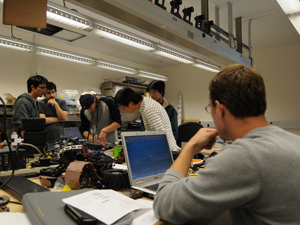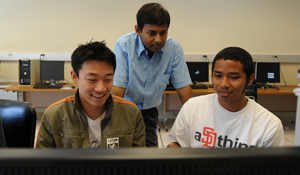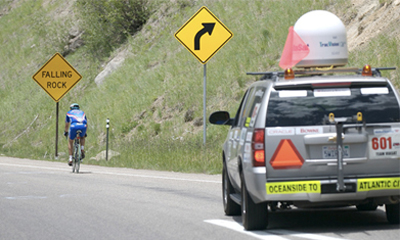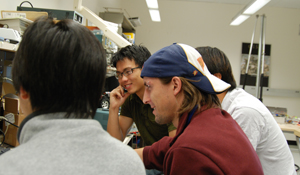Calit2 at UCSD Sponsors Three Projects in Spring Quarter ECE 191 Group Engineering Design Course
By Tiffany Fox, (858) 246-0353, tfox@ucsd.edu
San Diego, CA, June 18, 2008 -- Ten undergraduate students sponsored by the UC San Diego division of the California Institute for Telecommunications and Information Technology (Calit2) completed three research projects related to field programmable gate arrays as part of the Electrical and Computer Engineering (ECE) Engineering Group Design Project course.
|
ECE 191 is an upper-division class that provides undergraduate students with hands-on experience working in a team to design, build, demonstrate and document an open-ended engineering project. The six projects completed this quarter fulfill the requirement for the final exam of ECE 191.
Leading one of the teams were Calit2 staff researchers Javier Rodriguez Molina, Don Kimball and Jeff Cuenco, all members of Calit2's Circuits Lab at UCSD. They helped a group of students -- JaeYong Kim, Marvin Tu and Phillip Thai -- successfully implement a self-navigating component that incorporated a global positioning system and a digital compass onto an existing Gizmo device. Gizmo is a technologically sophisticated mobile communications device designed to be used at disaster sites or in other emergency situations. Resembling a remote-controlled truck, it collects and transmits in real time any information that emergency personnel need via any communications system that they're using.
The team of students also developed an algorithm for the device that used infrared sensors for object avoidance. The signals turn the Gizmo truck in the correct direction to avoid any obstacle.
Advisor Jeff Cuenco, who interviewed the team at the beginning of the quarter, said he was impressed with how much the team of students knew going into the project.
“For being electrical engineers, they were actually quite well-versed in various types of programming,” he said. “Not just embedded Linux, but real micro-controller-based embedded coding as well as FPGA [field programmable gate array] experience. So it was actually kind of neat.”
|
In addition to the Gizmo project, Calit2 also sponsored two ECE 191 research teams that addressed FPGA implementation of digital communications systems. One group -- made up of students Alvin Sheih, Chang Ho Han and Bunreth Nhong -- focused on the FPGA transmitter and timing recovery loop. Another team of students – Mujib Haider, Lynn Greiner Ryan Honor and Nimit Pandya – sought to simulate and analyze FPGA frequency recovery. Both groups were advised by Calit2-affiliated researcher and ViaSat system engineer Nandan Das.
Student Bunreth Nhong said Das “was probably the best teacher that we’ve had at UCSD.”“He would show up at odd hours to help us out,” he added. “He really cared. Who shows up on a Friday afternoon to help out students?”
Nhong said he also highly valued the course itself.
“We learn these concepts theoretically, but this class puts it into perspective,” he said. “It’s practical. What we learn stays in our head.”
|
Presenting the team with the award was ECE Professor Pankaj Das. He said he and fellow ECE Professor Clark Guest – who co-teaches ECE 191 -- were impressed that the project was at that moment being used in a chase vehicle manned by Pateros, who was in New Mexico at the time of the group’s presentation along with a team of bicyclists.
“This is the first time that a project has gone from concept to application in the real world in one quarter,” Das said. The team received a $100 gift certificate to the UCSD Bookstore for their efforts.
|
Said team member Tim Fair: “I didn’t expect to win. I thought the other projects were a lot more complicated than ours. But we designed something that’s actually working out in the real world.”
Fair’s colleague, Brian Steiber, pointed out that the device has other applications outside of competitive biking, including use by public safety officers as a more robust PA system.
Also completing a course project was a team that designed and tested two high-gain, high-frequency and low noise left-hand circular polarization patch antennas for satellite phones. Mentor Max Sun of Hughes Network Systems advised students Tzu-Yu (Joey) Pao, Stanley Nguyen and Stan Hong on the project.A team made up of students Homan Chris Karimi, Mike Mesri and Scott Sakurai investigated an efficient and effective method for rekeying a network by examining three different multicast protocols for IPsec applications. That team was advised by Tiffany To of Booz Allen Hamilton (a strategy and technology consulting firm) and Richard Phipps of SPAWAR Systems Center, which develops communication technologies for the U.S. military.
Media Contacts
Tiffany Fox, (858) 246-0353, tfox@ucsd.edu
Related Links





